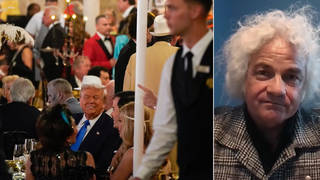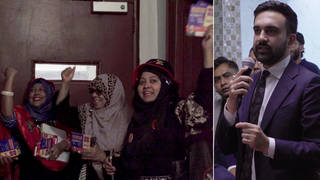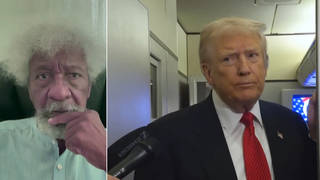
Topics
Guests
- Bruce Cumingshistory professor at the University of Chicago. He has written several books, including Korea’s Place in the Sun: A Modern History.
Envoys from the U.S. and North Korea have begun a second day of face-to-face talks in Beijing about North Korea’s nuclear program. Negotiators on both sides have refused to comment on the progress of the talks, but North Korea’s official news agency said the U.S. invasion of Iraq shows that other countries need a strong physical deterrent force to protect themselves. A memo from Defense Secretary Donald Rumsfeld, leaked earlier this week, urging removal of the North Korean government has exacerbated tensions.
The U.S delegation is being led by Assistant Secretary of State James Kelly. The last time Kelly met with a North Korean delegation, he accused them of pursuing a clandestine nuclear weapons program, sparking the crisis in October. President Bush then suspended all aid shipments. North Korea restarted its nuclear program, expelled U.N. inspectors and withdrew from the Nuclear Nonproliferation Treaty. Last week, North Korea announced that it is already reprocessing spent fuel rods — a necessary step to produce weapons-grade plutonium.
All of this comes as the Pentagon has acknowledged for the first time that the Bush administration intends to produce — not just research — a thermonuclear bunker-busting bomb. Federal officials signed documents in Washington this week to launch a preliminary design contest between Lawrence Livermore National Laboratory and Los Alamos National Laboratory in New Mexico. The San Jose Mercury News reports the so-called Robust Nuclear Earth Penetrator will be a full-power hydrogen bomb that would throw up enormous clouds of radioactive dust while wreaking large-scale damage and death if used in an urban area. The bomb will be thousands of times more powerful than the conventional bunker busters dropped on Baghdad.
Transcript
AMY GOODMAN: Envoys from the U.S. and North Korea have begun a second day of face-to-face talks in Beijing about North Korea’s nuclear program. Negotiators on both sides have refused to comment on the progress of the talks, but North Korea’s official news agency said the U.S. invasion of Iraq shows that other countries need a strong physical deterrent to protect themselves. A memo from Donald Rumsfeld urging removal of the North Korean government, leaked earlier this week, has exacerbated tensions.
The U.S delegation is being led by Assistant Secretary of State James Kelly. The last time Kelly met with a North Korean delegation, he accused them of pursuing a clandestine nuclear weapons program, sparking the crisis in October. President Bush then suspended all aid shipments. North Korea restarted its nuclear program, expelled U.N. inspectors and withdrew from the Nuclear Nonproliferation Treaty. Last week, North Korea announced it’s already reprocessing spent fuel rods — a necessary step to produce weapons-grade plutonium.
All of this comes as the Pentagon has acknowledged for the first time that the Bush administration intends to produce — not just research — a thermonuclear bunker-busting bomb. Federal officials signed documents in Washington this week to launch a preliminary design contest between Lawrence Livermore National Labs and Los Alamos National Lab. The San Jose Mercury News reports the so-called Robust Nuclear Earth Penetrator will be a full-power hydrogen bomb that would throw up enormous clouds of radioactive dust, while wreaking large-scale damage and death if used in an urban area. The bomb will be thousands of times more powerful than the conventional bunker busters dropped on Baghdad.
Last night, University of Chicago professor Bruce Cumings came to New York and spoke at New York University Law School. He’s written several books on Korea, including Korea’s Place in the Sun: A Modern History. This is professor Bruce Cumings.
BRUCE CUMINGS: The title of my talk tonight is “North Korea: The Sequel.” And it’s a sequel in two or three different meanings. But clearly, from the North Korean point of view, the crisis that began last October and continues today has been run as a virtual replay of a crisis in 1993 and 1994 that very nearly led to a terrible war in June of 1994. As many of you will remember, however, that particular crisis over North Korea’s nuclear facilities was derailed by Jimmy Carter, who flew off to Pyongyang, negotiated a freeze on the Yongbyon graphite reactor with — directly with Kim Il-sung. And in October of 1994, the so-called Framework Agreement codified the freezing of North Korea’s graphite reactor. In return, among other things were promises to build light-water reactors 10 years later to substitute for the graphic reactors. The U.S. also pledged to normalize relations with North Korea in that agreement and to stop threatening North Korea with nuclear weapons. All of that seemed to go rather well in the 1990s, although the U.S. dragged its feet very much in building the light-water reactors. But in the year 2000, President Clinton and a team that had done a great deal to revamp American policy toward North Korea also came very close to buying out North Korea’s medium- and long-range missiles.
All of that was aborted when the Florida election turned out to be — or, the 2000 election turned out to be aborted. Five weeks later, the Supreme Court decided 5 to 4 who would be our president. And from that point onward, the Bush administration has been throwing monkey wrenches into our previous arrangements with North Korea and the extraordinary progress that Kim Dae-jung made in North-South reconciliation. It wasn’t clear in the first year of the Bush administration exactly what they were going to do, and I think one thing I want to point out is the Bush administration doesn’t know what it wants to do regarding North Korea because it’s so deeply split within. Unfortunately, the split recapitulates the split over Iraq, with hard-liners like Rumsfeld and Cheney being hawks on both Iraq and North Korea; the secretary of state and the State Department, really since Bush came in, being in favor of negotiations with North Korea. I’ll come to that in a minute. But a year into the administration, in the State of the Union address a year ago, President Bush linked North Korea with an “axis of evil,” as you all know, involving Iraq and Iran. Still, though, if you look at the record in the early first nine months of 2002, North Korea reopened high-level talks with the South. They kept calling for talks with the United States. And it isn’t clear that the lumping together of North Korea into that axis of evil made a huge difference to them.
What did make a difference was the September 2002 preemptive doctrine that the National Security Council released last September, which was interpreted by Condolleezza Rice as a doctrine of anticipatory self-defense but has clearly become a doctrine of preventive war now that we launched a war against Iraq. North Korea was extremely upset by that doctrine and began claiming that they were a target of the doctrine. And as if someone were trying to feed North Korean paranoia, leaks to the press in September said indeed that North Korea was a target of that doctrine.
The next month, James Kelly, who today is negotiating with North Korea in Beijing, James Kelly went to Pyongyang and tabled American intelligence information suggesting that North Korea was involved in a new nuclear program to import highly enriched uranium technology and essentially build a bomb the Pakistan way. They traded their missiles for Pakistani enriched uranium technology. There’s still much dispute about what really happened at that meeting, but from that meeting onward, North Korea began replaying their sequel almost on fast-forward.
In other words, in March 1993, they left — said they were leaving the Nonproliferation Treaty. They kicked the U.N. inspectors under the International Atomic Energy Agency out of the country. This crisis bubbled on for about 15 months. And then, when they took 8,000 fuel rods out of their reactor in May 1994, the fat was in the fire, so to speak, and that’s what caused the Clinton administration to come very close to a preemptive strike that would presumably take out the Yongbyon facility. This time, in December, in the space, really, of about three weeks, they once again withdrew from the NPT, kicked the inspectors out and announced that if the U.N. were to impose sanctions on North Korea, this would be interpreted as an act of war. It’s exactly what they said in 1993 and ’94. So North Korea ran, essentially, their game plan that they did 10 years ago but stopped short of actually beginning to reprocess those 8,000 fuel rods.
I was part of a task force on U.S. policy toward Korea with Selig Harrison and various other people, some of them former Clinton administration officials, and I remember one of them saying last October he was quite convinced North Korea was going to detonate a nuclear explosive, because they never have done that, and they can’t really tell if they have an atomic bomb that will work or not until they do that. He is a former ambassador himself and was very adamant about that. Here we are almost in May, and that hasn’t happened, either.
This week, it turned out that we got the North Korean talking points for the October meeting last year. They were discussed in The Washington Post on Sunday. Those North Korean talking points that were presented to Mr. Kelly touched on four key areas: nuclear inspections, which North Korea said could be negotiated; the light-water reactor project, that was supposed to be completed by this year; the future of American forces on the Korean Peninsula; and North Korea’s development and export of ballistic missiles. This was the North Korean agenda. It seems clear from that agenda that they wanted to go back to the agreements they negotiated with the Clinton administration.
The trouble is, this is not the Clinton administration. I don’t mean that in a partisan way, but it’s not an administration like either Clinton’s or George H.W. Bush Sr.’s administration, which actually inaugurated high-level talks with North Korea. This administration is so deeply split that Senator Joseph Biden last week said a San Andreas Fault runs through the Bush administration when it comes to what to do about North Korea; newspaper accounts that said that when officials get together, there will be 12 different proposals from six or seven different people, but no consensus.
Mr. Bush, however, is on record as saying he loathes Kim Jong-il. He told that to Robert Woodward last August. He’s also on record calling Kim Jong-il a “pygmy.” This is not the way heads of state talk about each other, but then we have an inexperienced head of state. I suppose it also takes one unelected princeling to hate another unelected princeling.
That’s essentially where we are now. The Bush administration is saying, and our press is dutifully repeating, that North Korea blinked and agreed to talks in a multilateral forum. It’s true that in the middle of the war against Iraq, North Korea said that the forum itself is not so important if the U.S. and North Korea could talk. That was an opening that Beijing exploited to essentially arrange tripartite talks, which are what are going on for the next three days in Beijing. I was on an airplane, so I don’t know if there was any news about that today, but I doubt that there will be news for a few days. And I’m quite skeptical that there will be much coming out of these talks. But Mr. Bush backed down in a very big way, as well, by — you may remember that for six months the Bush administration principle was they wouldn’t talk to North Korea at all until North Korea began dismantling their nuclear programs, and if they were going to talk, that’s all they wanted to discuss, was how they were going to dismantle those programs. So both sides backed down and blinked. That’s what you call diplomacy.
And Colin Powell and the State Department have been advocating that for some time. The Washington Post on Sunday reported that Powell was only able to do this because Don Rumsfeld was so fixated on the War in Iraq that he didn’t even notice that these talks were set up. If, however, this particular scenario plays out as the War in Iraq did, we’re really in trouble, because Colin Powell was sent on a variety of essentially meaningless diplomatic maneuvers leading up to the War in Iraq, especially at the U.N., while Bush talks to Cheney over lunch with no one else present once a week, Bush talks to Rumsfeld over lunch with no one present once a week, and, clearly, they had the whip hand of policy because we ended up invading Iraq without provocation. And even the goal of the war, to find weapons of mass destruction, so far has come up empty-handed. Seymour Hersh quoted a high official in the Bush administration last fall, and I think it was Cheney, but he can’t say it was Cheney, as saying they want to topple the regime, and they want Kim Jong-il’s head on a platter. So, get ready for the next sequel in the Bush administration’s preventive wars.
Let me take you back in the time remaining to a different sequel that I think is not well understood. In 1949, another administration was deeply split over what to do about East Asia, Korea, China. The Truman administration — Harry Truman appointed Louis Johnson as the secretary of defense. And in the summer of 1949, Johnson came in to an administration already committed to the containment doctrine for two years and began pushing for a liberation or rollback doctrine against the communist sphere. Containment was not funded at that time in any big way, and it was unstable in the body politic in that the Truman administration was being attacked, especially by Republicans, for a passive, not to mention pusillanimous, policy. What is less well known is that inside the administration there were strong advocates of a liberation or rollback policy. And when you look at the documents leading up to the most important policy for Asia, NSC 48, approved by Truman at the end of December 1949, you see that this split within the administration was embodied within that document, and the public language, or the consensus language, was our policy is to contain and, where feasible, to reduce the hold of communist governments in the world.
And the realm of feasibility and the discussion of reduction is exactly what happened during the Korean War when we went into the Korean War to defend South Korea and restore the 38th parallel. But in the summer of 1950, a very powerful coalition in Washington developed to do a rollback into North Korea. This was Truman and Acheson’s policy, not MacArthur’s policy, although MacArthur agreed with it. And in September, the NSC approved a document calling for a rollback into North Korea. This brought on a war with China. Truman declared a national emergency in December of 1950. It was clearly the worst foreign policy crisis of the Cold War, until the Cuban missile crisis in 1962. When China came into the war, something a little bit over 2,000 Americans had died, some tens of thousands of Koreans had died. When the war ended three years later, 33,000 more Americans were dead, and perhaps as many as 3 million Koreans and 1 million Chinese, and the war ended where it began.
In December 1950, in the midst of that emergency in this country, Kim Il-sung and his allies were in a town called Kanggye near the Chinese border, and the United States sent B-59s to drop — B-29s to drop so-called Tarzan bombs on Kanggye, trying to decapitate the leadership. This was an enormous new 12,000-pound conventional bomb, never tried before. But you may have heard of the MOAB bomb that made the cover of Newsweek just before the war in Iraq, the “Mother of All Bombs.” It was 20,000 pounds of TNT equivalent.
So the North Koreans have had an experience of their entire territory being occupied, of their leadership being attacked, of the country being liberated. But when the Chinese came in and the North Koreans also fought very hard at this time, North Korea was cleared of American forces in about two weeks. After that, we dropped oceans of napalm and all kinds of bombs on North Korea until the war ended. And toward the end of the war, we actually opened up the enormous hydroelectric dams, that hold huge amounts of water, and flooded an entire area 27 miles south of one of them by bombing those dams. Nonetheless, the North Koreans never gave up.
I saw in The New York Times last week a comparison of the War in Iraq, this one, the previous one, World Wars I and II, the Korean War and the Vietnam War in terms of how many sorties we had to fly to make sure we had taken out a target. It was one in the most recent war, 10 in the last Iraq War, 550 in the Korean War. So, Korea was just wiped clean, especially North Korea, and barely a building was standing at the end of the war.
In September 1951, we launched Operation Hudson Harbor against North Korea, which was to essentially drop dummy atomic bombs on North Korea to see if it might be possible to use real atomic bombs. This was a highly secret project, but B-29s were lifted off of Okinawa, sent over Korea on a nuclear bombing run, just as we did with Hiroshima and Nagasaki. In 1958, we became the first power ever to introduce nuclear weapons into the Korean Peninsula. We had more than 600 there for decades. When they were finally removed in 1991, there were more than a hundred. We still do war games involving nuclear threats constantly every year, if not more often, against North Korea.
North Korea today is a failed state. It doesn’t seem to have a way out. It has, however, a huge independent army, more than a million strong, and enormous numbers of its 22 million population who have served in that armed forces.
These days you can talk about North Korea and say essentially anything. Recently, Greta Van Susteren introduced a Fox News segment on Kim Jong-il by saying, “Is he insane or simply diabolical?” then went to a commercial. Prominent Americans lose any sense of embarrassment or self-consciousness about the difficult and knotty problems of racial difference and otherness when it comes to North Korea and its leaders. Newsweek did the Bush administration’s work for it in January of this year with a cover story on “Dr. Evil,” Kim Jong-il, just as it covered Kim Il-sung’s death in July 1994 with a racist cover story entitled “The Headless Beast: North Korea.”
Meanwhile, what is the truth about the current administration? In my view, it’s running wild, like a wild bull elephant trampling on fundamental principles of international law and world peace. It launched what is clearly a preventive war, in violation of the U.N. Charter. In place of principles of national sovereignty, we have assassination, decapitation and regime change for people we don’t like. And we have utter contempt for those who differ with us, whether they be the French, the Germans or any other allies, South Korea being a prominent one these days. We liberated Iraq. It’s nice that they’re done with Saddam Hussein. It was a nasty police state. But it was a nasty police state like any number of others in the past 50 years, and nothing remotely comparable to Hitler.
North Korea, of course — let me say one more thing. Added to the Bush doctrine of preventive war is a fantastic, messianic fantasy about remaking the Middle East in our image as a prelude to remaking the rest of the world in our image — Central Asia, South Asia, Southeast Asia, you name it. They’re all going to go democratic and love the market, whether they like it or not. And we have overextended ourselves in ways that are unprecedented with any number of new military bases in some of the most unstable parts of the world, especially Central Asia, which we never had a strategic interest in, and, of course, the Middle East, where we’re already using Iraqi military bases for the long run.
North Korea clings with a passion, and has since its foundation, to the original Western doctrine of national sovereignty, self-reliance and so forth. That’s its basic raison d’être as a postcolonial state after 40 years of very brutal Japanese colonialism. North Korea is nothing to write home about. It’s a state that’s almost impossible to defend. But unlike Saddam Hussein and Iraq, it grows out of the revolutionary nationalism that swept East and Southeast Asia after World War II. We tried fighting that once in Vietnam and got defeated. We tried fighting it before that in Korea and got stalemated.
If we try to fight it again, we’re going to cause a horrible catastrophe. I would recommend to you the article by Doug Struck on the Sunday Washington Post that had those talking notes that I mentioned earlier in my presentation. He said that according to some estimates in Washington, the first day of a new Korean War would kill at least a million people. Thank you.
AMY GOODMAN: Professor Bruce Cumings of the University of Chicago, professor of history, author of Korea’s Place in the Sun: A Modern History. If you’d like to get a copy of today’s program, you can call 1-800-881-2359. That’s 1-800-881-2359. Back from our break, we’re joined by Grace Paley. Stay with us.












Media Options